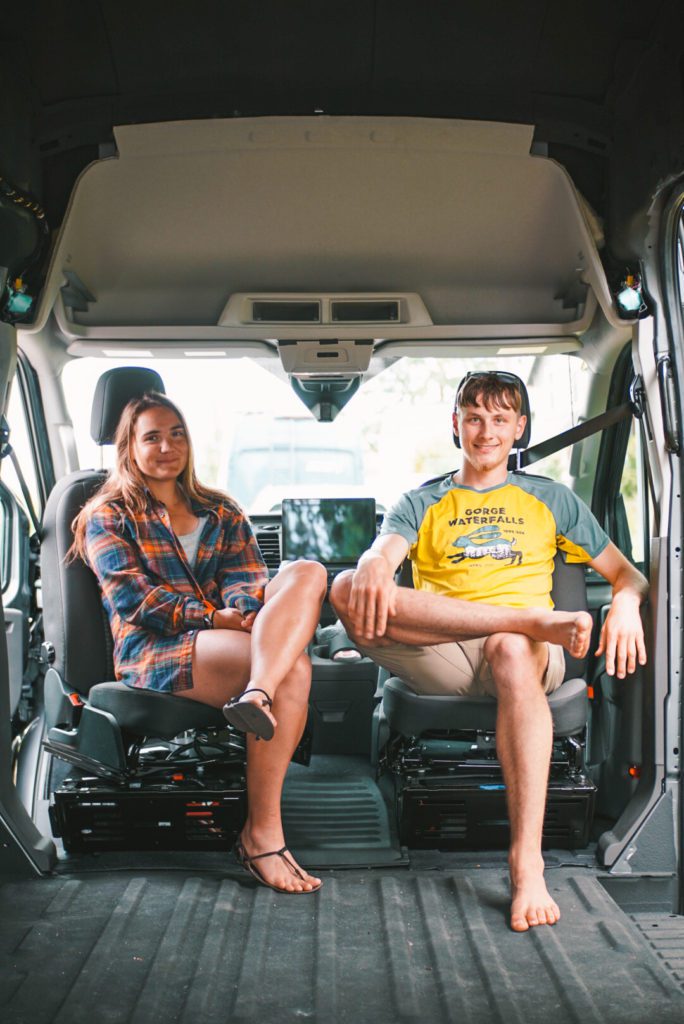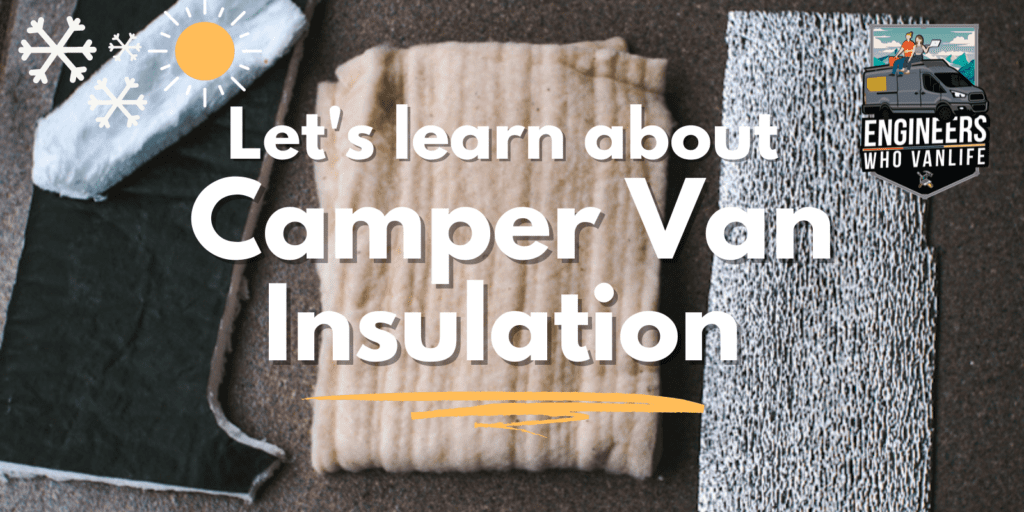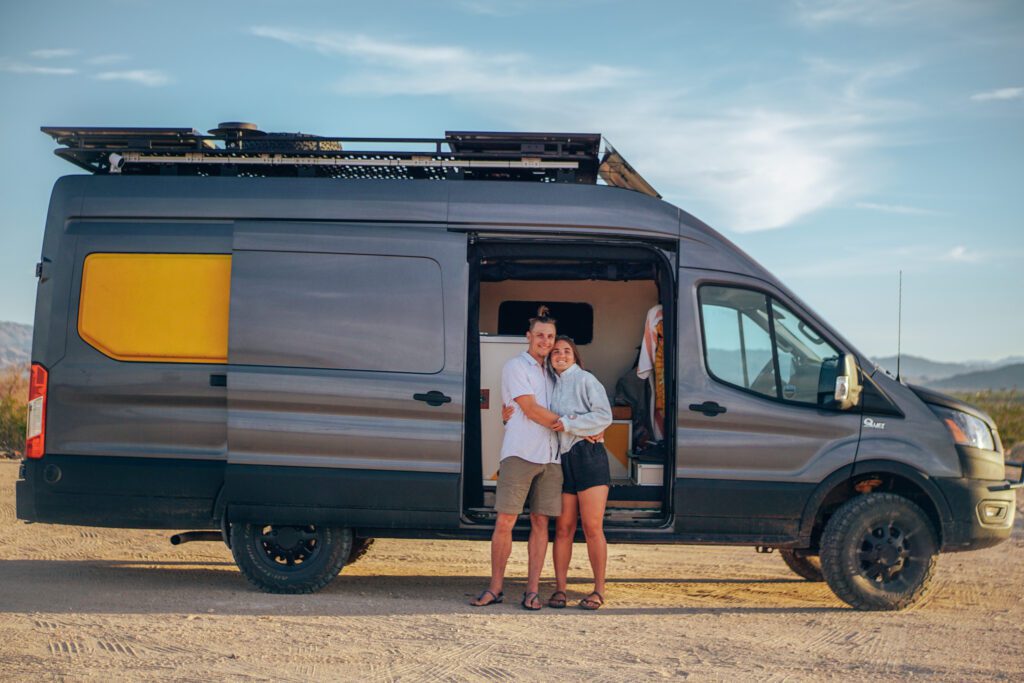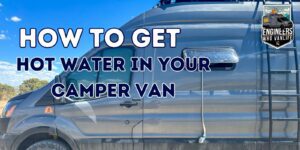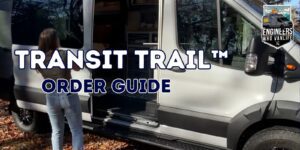Winter Van Life is HARD but THE BEST
We have spent two winters living out of our DIY Ford Transit camper van conversion chasing powder. While winter van life comes with struggles, it is our absolute favorite season of van life. However, it is not for everyone and specific considerations must be made during your van build to create a camper van home that will make for a happy winter van life. Before we dive into those considerations, we also want to share some ways that winter van life differs from typical van life:
- You spend more time in parking lots and won’t have the beautiful views that come with BLM camping (see “Overnight Parking”)
- You will spend a majority of the time inside your rig with your doors closed (see “Dealing with Time Inside“)
- Chores will take more time, and planning, as resources aren’t readily available
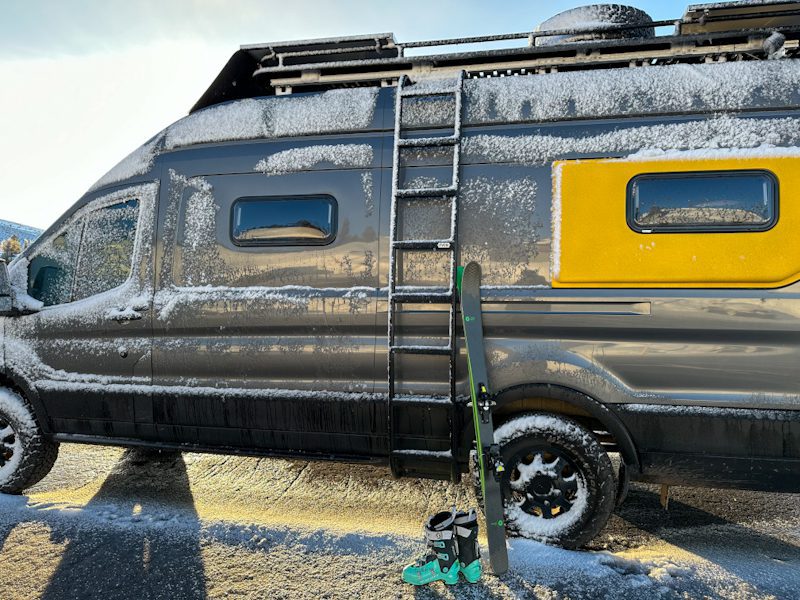
** Disclaimer: This blog post contains various affiliate links that provide a small kickback to us, at no additional cost to you. We truly appreciate your support if you choose to purchase through these! **
Heating Options for Camper Vans
Let’s start in the most obvious place: how do you keep your camper van warm when the temperature doesn’t get above freezing for months? You heat it and have proper insulation.
There are several options for camper van heaters and your decision will come to a combination of price range, elevation bands you plan to be at, and type of heater that makes sense in your van build:
- Diesel and Gasoline Air Heaters
- Hydronic Heating Systems
- Propane Heaters
Diesel Heaters and Gasoline Heaters for Van Life
Recommended For:
Most Van Lifers!
Diesel, and gasoline, air heaters are the most common heater that you will see in camper vans. We recommend these for most van lifers unless you are a powder chaser, or have the budget for a more integrated system (see “Hydronic Heaters“).

How do gas heaters and diesel heaters work?
Gasoline and Diesel air heaters are small units that often sit underneath your passenger seat. They hook into your existing fuel source (gas tank) and require a small amount of 12V power routed to them. These heaters produce hot air at a single small outlet. Camper van air heaters generally work by the following process:
- Pumping fuel to the heater to ignite a glow plug
- Lighting a small flame inside a contained combustion chamber, thus heating the heat exchanger
- Pulling air from outside your rig, around the heated heat exchanger, and pushing it out into your living space as hot air
Benefits
- Easy install: Install of these heaters is quite simple as they tap into your existing fuel tank. Most chassis have an auxiliary fuel port which you can attach to for this step. Additionally, the install of the heater requires cutting a hole in the floor, and routing power and fuel to it.
- Vented outside: Exhaust is safely routed outside your camper van so these are safe for your living space.
- Dry Heat: These air heaters essentially work as an air to air heat exchanger with the exhaust going outside of the van. This results in a dry heat which is essential for moisture control.
Cons
- Altitude considerations: As you go up in altitude, there is less oxygen in the air. These air heaters then have to decrease their “fuel sipping” rate to maintain the proper fuel to oxygen ratio. Because these camper van air heaters already sip so little fuel, they often don’t have much wiggle room to sip less. Therefore, most air heaters are rated to 5,000 feet only.
- Hot air only at one point: The output of these air heaters are isolated to one, small spot. It is hard to circulate hot air evenly around the van. Additionally, the output vent is usually under the passenger seat which can be far from the bed.
- Less temperature control: With smaller output, it is hard to control the temperature to a specific point. These heaters tend to be “on”, or “off”.
Examples of Gas Heaters and Diesel Heaters
Diesel Heaters for Van Life:
- Eberspaecher Airtronic S2-D2L (2kW)
- Eberspaecher Airtonic M2-D4L (4kW)
- CDH, “Chinese Diesel Heaters” (Buy at your own risk! We have never tried these but many folks have them)
Gasoline Heaters for Van Life:
Price Range
$1,000-$2,000
Hydronic Heaters for Van Life
Recommended For:
Powder Chasing Van Lifers With The Available Budget!
Hydronic heating systems provide various heating elements on the basis of a coolant loop. The heating elements not only include hot air, but also on demand hot water and heated floors!

How does hydronic heating work?
Hydronic heating systems work off of heated coolant that circulates around a “loop” and enters various heat exchangers. The heat exchangers take coolant in and then output hot air, or hot water. For van life, coolant reservoirs are typically isolated and standalone. However, you can alternatively splice into your chassis coolant system. Hydronic heating is energy efficient, works at high altitudes, and has a much higher heat output than air heaters.
Benefits
- More Heat: Hydronic heating systems put out more BTUs of heat because they are bigger and more powerful.
- On Demand Hot Water: Hydronic systems are more than just air heaters, they easily produce on demand hot water with little extra work. When factoring in the cost of this system, be sure to factor in that it is your hot air and hot water for the same price.
- Heated Floors: You can also add additional coolant loops to create energy efficient radiant floor heating!
- High Altitude Capable: Hydronic systems are rated to much much higher altitudes than standard air heaters. Usually they are rated between 10-16k feet.
- Controllable Thermostat Function: Most hydronic heating systems have temperature sensors and the ability to control the temperature of your living space with a thermostat. This saves power and will allow you to leave the van for longer periods of time with comfort.
- AC Power Option: Typically there is an additional AC power option so you can utilize electricity instead of fuel if connected to shore power.
Cons
- Cost: These systems come in around $5,000 which is the biggest prohibitor in installing a hydronic system.
- Install difficulty: These systems are much more difficult to install and require some basic understanding of coolant loops.
Examples of Camper Van Hydronic Heating Systems
- Eberspaecher AquaSystem (currently Diesel only, Gas coming soon!)
- Timberline System
- AquaHot 125G (or D for diesel)
Price Range
$4,000-$6,000
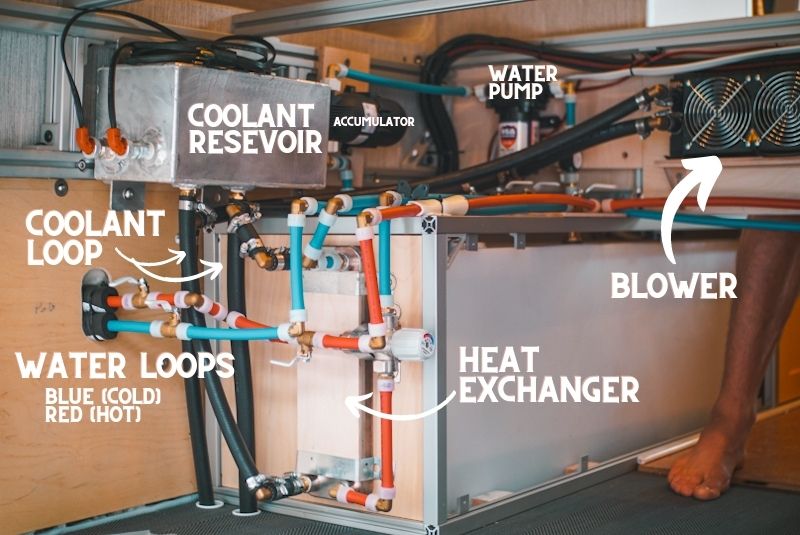
Propane Heaters for Van Life
There are two categories of propane heaters: the emergency “off the shelf” heater, and Propex heaters.
Mr Buddy Heaters
Sometimes there isn’t time, or budget, to install a proper heater in your camper van. In this scenario, we often see van lifers buy a Mr. Buddy, or similar heater as an interim solution when mornings start to get cold. While this works in a pinch, there are a few important considerations:
- You must have a window, or other form of vent open at all times when running this to vent CO
- Never leave this heater unattended
- This heater is not vented outside, therefore, is not a dry heat and will increase humidity inside your rig
Propex HS2000 Air Heater
The Propex HS2000 Air Heater is similar to gas heaters and diesel air heaters discussed above, including the same pros and cons. The main difference is that propane is the fuel source instead of your gas tank. This does lead to a cleaner burn, thus maintenance should be easier. However, we have heard that the heat output it much less for propane heaters. For this reason, we only recommend a Propex heater if you currently have a solid propane system on board.
Recommended For:
Van Lifers With a Propane System Onboard Already
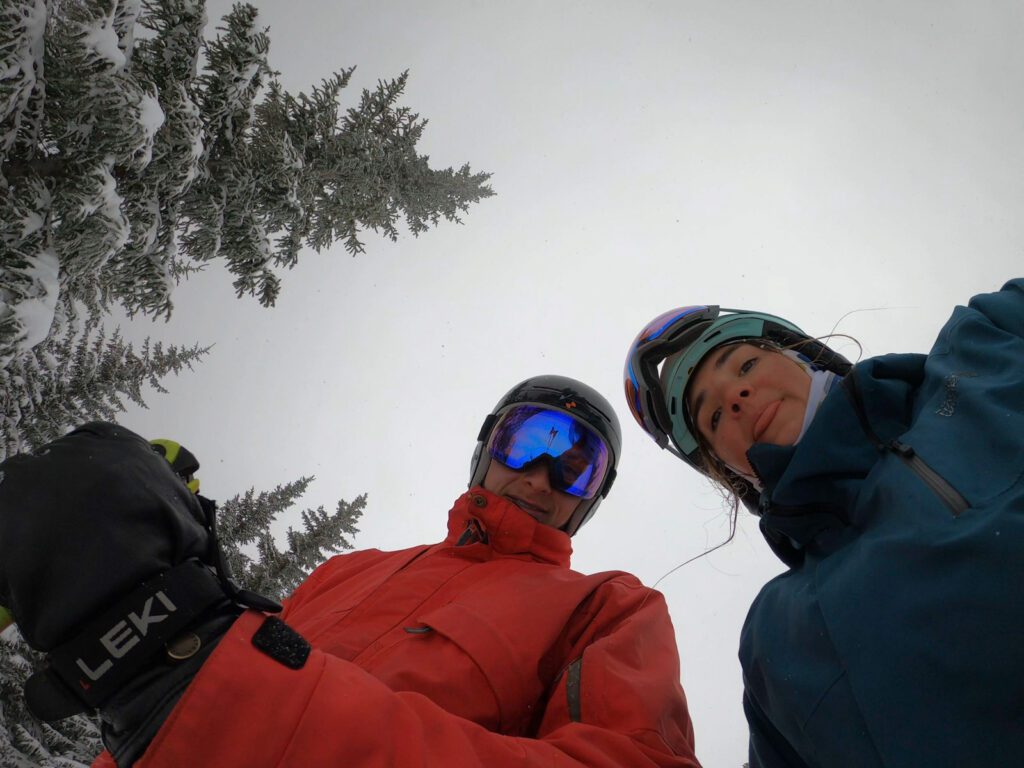
Van Life at Altitude Considerations
Often times winter van life comes along with living at higher altitudes. Besides the obvious prep for physically being at a high altitude, here are a few other considerations:
- Food cooks differently (longer) at altitude. Generally, boiling temperature decreases and cooking times will increase. The hardest thing for us to figure out was how to properly cook rice at 10k feet. Because of the longer cooking times, this will hit your battery bank more, so be sure to have solid ways to charge your batteries.
- Not all heaters function at altitude. Because of the decreased oxygen in the air, some heaters will fault out (see Heaters section and be prepared with a backup plan).
Insulation for Winter Van Life
There is nothing that highlights insulation gaps in your van build than a deep winter. We recommend having a solid mass insulator, effective sub floor, and insulated professional window shades. If you are confident in your ability to DIY window shades, you can also do that; however, if you do not do them perfectly, they will not be effective! Window shades are one of the few projects we don’t recommend DIY-ing.
- Mercedes Sprinter Insulated Window Shades
- Ford Transit Insulated Window Shades
- Ram ProMaster Insulated Window Shades
Best Mass Insulation Strategy for Winter Van Life
From our experience, the best camper van mass insulation strategy is:
- Havelock Wool in all cavities and behind wall panels
- 3M Thinsulate behind ceiling panels
These two materials are very comparable in terms of insulation effectiveness, but where they differ is application ease. Havelock Wool is incredibly easy to stuff into cavities, and behind panels. 3M Thinsulate does better with spray adhesive application such as the ceiling.
Complete Guide:
Campervan Insulation Strategy
Subfloor Considerations for Winter Van Life
You will also want a solid, well insulated subfloor during the winter. Camper van floors tend to become cold as ice because of the air flow underneath the van. A properly insulated subfloor can be done with “pink board” or other rigid insulation material. We have a guide dedicated to DIY, and professional subfloor options.
To take it one step further, you could add in floor radiant heating if you opt for a hydronic heating system. Or, you could install 12v heated silicone mat flooring underneath your top floor.
Condensation Control
Keeping condensation down is crucial to van life during all 4 seasons; however, it can become a bit more pertinent during the winter season. The last thing you want is to have condensation freeze, and expand in areas that it shouldn’t. Or to collect in your windshield when you are sleeping and then take forever to defrost in the morning (this is usually the first sign you need to step up your condensation control!!).
Lucky for us van lifers, camper vans are small spaces so it is pretty easy to control condensation. Here are some tips:
- Maintain moving air. There should always be air being pulled in, and a way for air to escape. Yes, even when it is absolutely freezing outside you need to be circulating fresh air. The easiest way to do this is with 2 MaxxAir fans. However, you could utilize a window if you only have one.
- Dry all winter gear promptly. Make sure you have hooks, or another way, to hang all of your winter gear to fully dry out after use. By your heater is a great spot to open up your boots, or you can get portable boot driers.
- Cook near an open fan, or window. In the summer, fall, and spring, we almost always cook with the doors open (hello views!) however, in the winter, you will almost always have your doors closed to keep in heat, so it becomes extra important to have a way for the moisture to escape.
- Opt for a portable induction stovetop instead of gas. Take the cooking one step further and opt for an induction stovetop in the winter as they produce less moisture than an open flame.
Colorado Winter Van Life Perk
Colorado is DRY and that is one of the (many) reasons we love winter van life specifically in Colorado. Our wet gear, clothes, and composting toilet (LOL) dried extremely quickly.
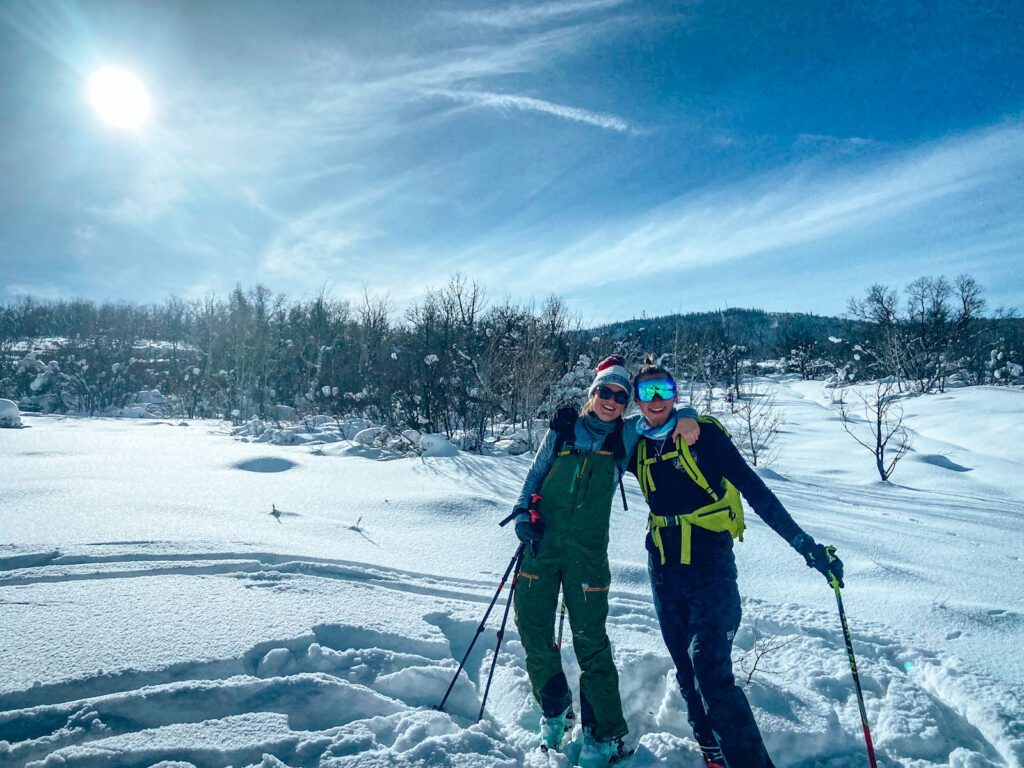
Dealing with More Time Inside
The cold temperatures, and constant snow, equate to more time inside your camper van with the doors closed. In fact, I don’t think we ever spend time with our slider door open for the sole purpose of holding in heat! This can become difficult and really emphasize how small your living quarters are.
Here are some of our tips for getting easing the tension of being cooped up:
- Look into community events such as trivia nights, or other get togethers
- For couples: do your snow activities separately sometimes so each person can have some alone time in the van!
- Keep your camper van clean, and have everything put away as much as possible
- Build your camper van interior for this exact scenario. We personally built our rigs living quarters around winter and we love it
- Go out to eat!
- Go to the movies!
- Explore the community around you!
Overnight Parking in the Winter
Winter van life is nothing like the glorious van life we all picture. There is little to no BLM camping, or public land camping at all. A majority of the time will be spent in parking lots, or rest areas. However, do not let that deter you, winter van life is seriously some of our favorite months in the van despite what it may sound like! Some of the best places to look for winter van life parking are:
- Hotels
- Rest Areas
- Ski resorts (see note below)
- City Streets
- Cracker Barrel, REI, Walmart, Cabela’s.. you know the deal
Ski Resorts For Winter Overnight Van Camping
Ski resorts used to be a reliable option for free overnight parking; however, as the years go on and van life becomes more popular, many ski resorts are cracking down. They now completely ban overnight parking, or require a fee, often of $20+. At the time of writing this (June 2023), these are the resorts we know of that allow free overnight parking:
- Winter Park (Colorado)
- Purgatory (Colorado)
- Wolf Creek (Colorado)
- Monarch Mountain (Colorado)
- Bogus Basin (Idaho)
- Whitefish Mountain Resort (Montana)
- Taos (New Mexico)
- Mt Hood Meadows (Oregon)
- Timberline Lodge, Climbers Lot (Oregon)
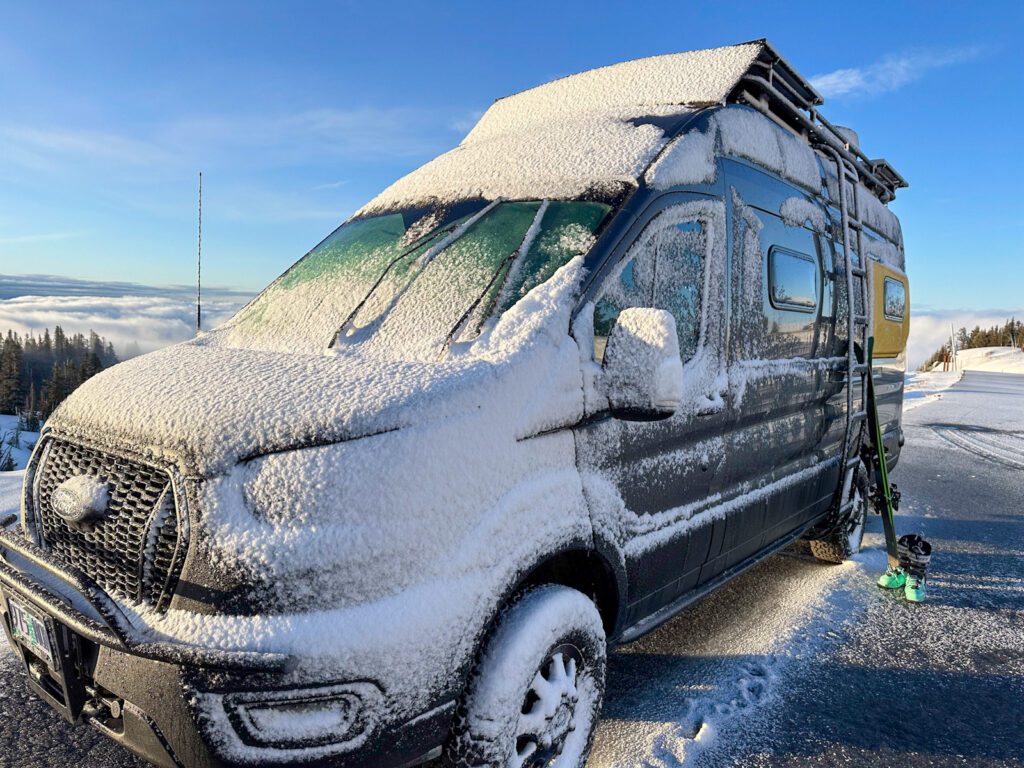
Getting Water in the Winter
One of the chores that becomes more difficult in the winter is filling your water tank. Many of the typical water fills will close because of the below zero temps. We solve this problem in two ways:
- Stretching our water tank as long as possible. We do this by carrying around collapsible 3L bladders and filling them in sinks or water stations whenever we see them. This alone doubles our water tank life!
- Having various ways to fill our water tank besides a spigot. Our favorite way is by using the MRX+ Off Grid Water System to pump water in from streams. We were able to find many streams and rivers that weren’t frozen in Colorado.
Power / Energy Supply Considerations
With shorter days and generally a lower amount of solar energy reaching the ground in the winter, we do not recommend relying fully on solar power for winter van life. You should either add shore power, or DC-DC charging. Between our solar array and 2x DC-DC chargers, we have only ever had to plug into shore power once during our winter van life career.
Winter Van Life Power Saving Tips
While doing winter van life, we encourage you to keep a close eye on the forecast. If you see a long stretch of “cloudy” days, you can implement small power saving tricks to get you through to the next sunny day. Some of the power saving tricks we use are:
- Turn off your inverter whenever it is not in use
- Make overnight oats for breakfast (no power breakfast!)
- Charge laptops, phones, and electronics at coffee shops
- If you have to drive.. cook dinner before you drive so that you charge back up after
- Park deliberately in non-shaded spots

Useful Items to Have Onboard for Winter Van Life
There are more “things” that we recommend keeping onboard your camper van during winter. These are things that make dealing with snow easier, getting unstuck quicker, and of course help with the colder temperatures.
- Extra blankets! These also double as insulation if you notice a large insulation gap. Shove that blanket in there!
- Snow Shovel. We use our avalanche shovels as they are compact.
- Collapsible Water reservoirs for filling up at resorts to extend your water tank 😉
- Extra long snow brush for your solar panels, and large windows
- Ladder to get to your roof for clearing your panels
- Merino wool base layers (wool does well without frequent cleaning!)
- 12v heated blanket
- Chill Screen (if you have a Bug Wall!)
- Indoor shower
Emergency Preperation
- Go Treads Recovery Boards
- Garmin InReach SAT phones
- Tire Chains
- Snow Tires

Winter Driving
If you spend winter van life chasing snow, you are going to spend a lot of time driving on snow and ice. While these are both skills that take time and practice, here are a few important notes:
- Know your drive train and how it drives.
- FWD, RWD, AWD, 4X4 all drive differently and enable different levels of traction and control; however, BRAKING distance is more or less consistent throughout. It’s called “4WD” not 4W stop 🙂
- Quality snow tires are essential. “All season tires” will not do.
- AWD or 4×4 rigs will give you more confidence on the snow and ice.
- Improved clearance is helpful for fresh snow. We have the Quigley Q Lift and have pushed through 12″+ of fresh snow.
- Driving slower will always be safer.
- Drive during sunlight hours.
Winter Van Life Summary
While there is a lot to consider, and prep, for winter van life, it is our absolute favorite season and we highly recommend giving it a try at least once. It is an entirely different ball game where your focus will be shifted from beautiful campsites to enjoying snow sports and being cozy. Everything matters a little bit more regarding your van build like thorough insulation, condensation control, and external upgrades. The basics like how to get water and how much power you have been more pertinent. But, the experience of living at the base of snow covered peaks is worth it all.
Let us know in the comments: have you done winter van life? Would you?
Recommended Next:
How we House Sit as Van Lifers
Thanks for being here! Happy building!
Eric + Colby
✉️ Join our mailing list for more content!
🙏🏽 If you are looking for more 1:1 van build help, we are here to help via Consulting or Travel Van Building.
[Start Here] Beginner Guides:
